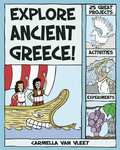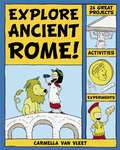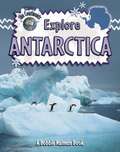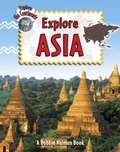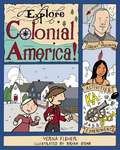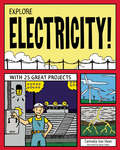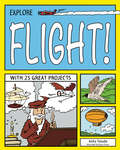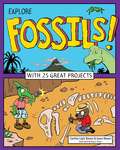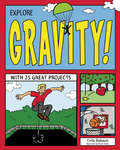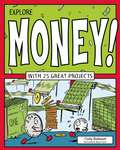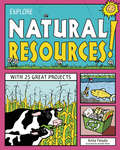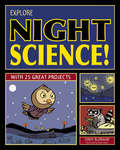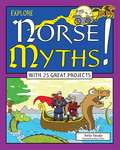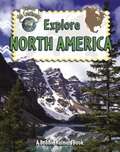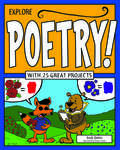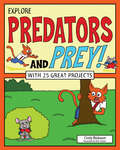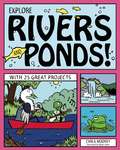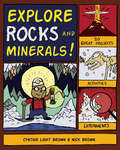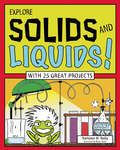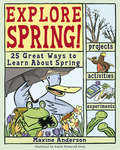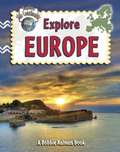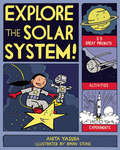- Table View
- List View
Explore Ancient Greece!
by Carmella Van Vleet Alex KimInvestigate the fascinating civilization of ancient Greece through 25 hands-on projects and activities for young readers ages 6-9. Kids learn about ancient Greek homes, food, playtime, clothing, conquests, arts and entertainment, gods, and more. Activities range from fashioning a model oil lamp from clay to building a courtyard column and constructing a flipbook sailing ship. By combining a hands-on element with riddles, jokes, fun facts, and comic cartoons, kids Explore Ancient Greece! and develop an understanding of how this ancient civilization still influences our modern world.
Explore Ancient Rome!
by Carmella Van Vleet Alex KimInvestigate the fascinating civilization of ancient Rome through 25 hands-on projects and activities for young readers ages 6-9. Kids learn about ancient Roman homes, food, playtime, clothing, conquests, gods, entertainment, and more. Activities range from creating an amphora and making a tunic to baking bread and hosting a Roman feast. By combining a hands-on element with riddles, jokes, fun facts, and comic cartoons, kids Explore Ancient Rome! and develop an understanding of how this ancient civilization laid the foundation of our modern world.
Explore Antarctica (Explore the Continents)
by Bobbie Kalman Rebecca SjongerThis book explores Antarctica--the freezing continent in the south pole: its geography inhabitants and other interesting facts.
Explore Asia (Explore the Continents)
by Bobbie Kalman Rebecca SjongerThis book explores Asia--the biggest continent in the world. It also talks about its geography, people, famous tourist places and other interesting facts.
Explore Colonial America!
by Verna Fisher Bryan StoneIn Explore Colonial America!, kids ages 6-9 learn about America's earliest days as European settlements, and how the colonists managed to survive, build thriving colonies, and eventually challenge England for independence.How did the colonists build homes, feed and clothe themselves, and get along with the Native Americans who were already here? This accessible introduction to the colonial period teaches young children about the daily lives of ordinary colonists and offers fascinating stories about those who helped shape the emerging nation. Activities range from creating a ship out of a bar of soap and building a log home out of graham crackers and pretzels to making a wampum necklace. Projects are easy-to-follow, require minimal adult supervision, and use primarily common household products and recycled supplies.By combining a hands-on element with riddles, jokes, fun facts, and comic cartoons, kids Explore Colonial America!, and have a great time discovering our nation's founding years.
EXPLORE ELECTRICITY!
by Carmella Van Vleet Bryan StoneGiven the pace of how we harness and utilize electricity, as well as the importance of developing new sources of energy, electricity is a timely subject for kids to explore. In Explore Electricity! With 25 Great Projects, kids ages 6-9 will learn the basics of electricity: currents, circuits, power, magnetism and electromagnetism, motors and generators. They'll become more attuned to how much they rely on electricity in their daily lives. They'll also understand that while electricity is a wonderful resource, and one we've used to our advantage ever since it was discovered, the future of how we make and use electricity is still changing and there are things they can do today to impact these changes.This title invites kids to experiment on their own with 25 simple projects that will "spark" their learning and enthusiasm, including making their own clothespin switch, lemon battery, compass, electromagnet, and flashlight, as well as generating their own "lightning." These hands-on activities combined with informational text will excite kids about STEM? the interrelated fields of science, technology, engineering, and mathematics.
EXPLORE FLIGHT!
by Anita Yasuda Bryan StoneWho invented the airplane? When were airplanes invented? And why do planes have wings if the wings don't flap? Kids can answer these questions and more by jumping into the cockpit and soaring into Explore Flight! With 25 Great Projects, where they'll learn about the history of our human obsession to conquer the feat of flying.For kids ages 6-9, Explore Flight! With 25 Great Projects introduces them to the dreamers, inventors, aviation pioneers, and record breakers. They will read about the myths and legends of flying and about the wondrous flying machines of the past, present and future. They will learn that in the 15th century Leonardo da Vinci drew sketches of airplanes, helicopters and other flying machines, and that the first passengers in a hot air balloon were a sheep, a rooster, and a duck. Along the way, they will develop a better understanding of the rich history of aviation, investigate what causes flight, and learn about the science of aerodynamics. Projects and experiments range from making a paper airplane to building an airfoil. All the projects in this book are easy to follow, require little adult supervision, and use commonly found household products, many from the recycling.
Explore Fossils!
by Cynthia Light Brown Grace BrownIn Explore Fossils! With 25 Great Projects, readers can expand their dinosaur obsessions into learning opportunities that take them beyond Triceratops, Stegosaurus, and even Tyrannosaurus rex to other animals, plants, and microbes that lived long before humans. Explore Fossils! introduces young readers to the history of life on Earth as revealed by fossils. Kids learn how fossils form and about the different types of fossils and the world of long ago--its landscape and the plants and animals that lived then. Scientists use radiometric dating to test fossils to discover when they were made, what organisms made them, what those organisms used for energy, what killed them, and a whole lot of other information. All from rocks! That's a lot of information stored under our feet. Activities include creating plaster fossils, using popcorn to illustrate radiometric dating, and exploring what might have caused mass extinctions by making a lava flow and simulating an asteroid impact. By studying the past, not only do students meet amazing plants and animals, they are also encouraged to consider their own role in geological time to make thoughtful hypotheses about the future.
Explore Gravity!
by Bryan Stone Cindy BlobaumHow can something that grounds us and keeps us here on this earth be so invisible and mysterious? We're not talking about anything abstract and undetectable. We're talking about GRAVITY! Gravity is a force that affects everyone and everything. Gravity is something we can easily understand, even kids, especially if they have the right tools to teach them.Explore Gravity! With 25 Great Projects will introduce kids ages 6-9 to the basics of gravity, including concepts of matter, attraction, and gravitational pull. Projects include creating a working model of a scale to learn what "weight" really means and how it's affected by gravity. By playing with various weights to make a marvelous mobile, readers learn about the center of balance and how martial artists use this knowledge to throw their weight around. All the projects in this book are easy to follow, require little adult supervision, and use commonly found household products, many from the recycling box! The fun facts, trivia, jokes, comics, and hands-on activities will help kids discover the captivating science of gravity. Furthermore, the informational text and hands-on activities will excite kids about STEM, the interrelated fields of science, technology, engineering, and math.
Explore Money!
by Cindy Blobaum Bryan StoneIn Explore Money! With 25 Great Projects, money is more than something to earn, save, and spend. It's an opportunity to explore history, art, science, economics, and math! While checking out the change in their pockets and bills from their banks, young readers search for hidden treasures, learn how money can multiply, and see how countries keep their currency secure. Very large and very small numbers take on a new relevance when seen through the lens of money. Using familiar materials found in the home or classroom, young readers explore the cultural aspect of money as well as its physical properties, discovering how these properties have affected business and global relationships throughout history. Kids experiment with various substances to clean coins, scientifically test coin components, design their own currency, and plan how to allocate their own money. Understanding the whats, whys, and hows of currency helps children achieve financial literacy and establish a strong foundation for a healthy, life-long relationship with money. Explore Money! meets Common Core State Standards for literacy in language arts, and mathematics; Guided Reading Levels and Lexile measurements indicate grade level and text complexity.
EXPLORE NATURAL RESOURCES!
by Jennifer Keller Anita YasudaWhat are natural resources? And why is it important to prevent natural resources from being wasted? Explore Natural Resources! answers these questions. The 25 projects inspire young readers ages 6-9 to have fun while learning why natural resources are important to all living things and how every child can take care of the earth's resources through reducing, reusing, and recycling. Kids will read about national parks and early environmentalists, Earth celebrations, and the science behind renewable and nonrenewable resources. With projects and experiments ranging from making a wind-powered car and creating a solar catcher to calculating their water footprint, children will discover that everything comes from the earth. Projects are easy-to-follow, require little adult supervision, and use commonly found household products, many from the recycling box. Through a mixture of fun facts, trivia, jokes, comics, and hands-on activities, kids will Explore Natural Resources! and gain an appreciation of earth's resources, from its vast oceans to its open skies. Explore Natural Resources! meets common core state standards in language arts for reading informational text and literary nonfiction and is aligned with Next Generation Science Standards. Guided Reading Levels and Lexile measurements indicate grade level and text complexity.
Explore Night Science!
by Bryan Stone Cindy BlobaumExplore Night Science! encourages 6-9 year olds to safely explore and understand what happens around the world when it is dark outside. Readers are led step by step into integrated, active explorations that uncover the science and technology of the natural and physical world that surrounds them. Kids learn about the rod and cone cells found in their eyes as they test their color vision at night, create a chorus mimicking the sounds of nocturnal animals, and make a personal stardome. Sidebars highlight a real kid who discovered a supernova, how Stonehenge is an ancient almanac, and what elephants and moths have in common.Kids will be amazed at the adaptations used by plants and animals to survive and thrive in the dark of night. Whether they live in the country or in the city, kids will learn to use all of their senses to investigate the night.
Explore Norse Myths!
by Anita YasudaThe stories of Norse myths and legends are a terrific introduction to Viking culture, history, science, and traditions, which thrived in Scandinavia from the eighth to the eleventh centuries. But who were the Norse, who left their homelands in Denmark, Norway, and Sweden to trade, raid, and explore around the world? In Explore Norse Myths! With 25 Great Projects, young readers discover the remarkable people and mythical creatures of old. Learning about Norse myths means unearthing the origin of Viking beliefs, as well as exploring their ships, tools, and other technology that flourished for nearly 450 years. Along the way, kids will read how Norse myths helped explain the natural world from thunder to the seasons, from creation to death. They may be surprised at how Norse myths continue to influence modern culture in the form of movies and books, including the new series by Rick Riordan. Readers will read Norse stories and learn about the adventures of real Norse explorers, including Erik the Red and Leif Erikson. Through a mixture of fun facts, trivia, jokes, comics, and hands-on activities, kids will dig up Scandinavia's past and sail the seas along with the gods and giants in Explore Norse Myths!
Explore North America (Explore the Continents)
by Molly Aloian Bobbie KalmanThis book explores North America: its geography, people, famous tourist places and other interesting facts.
Explore Poetry!
by Andi DiehnPoems can be silly, serious, or fun, just like kids! Whether it’s the sing-song rhythm of a limerick, the serendipitous magic of a found poem, the deceptive simplicity of a haiku, or the easy familiarity of an acrostic poem, children are charmed by poetry. And what’s more fun than reading poetry? Writing it! In Explore Poetry! With 25 Great Projects children have fun learning about different forms of poetry while delving into different literary techniques such as personification, metaphor, and alliteration, all of which are discussed in a simple and accessible way. Activities include creative writing exercises designed to reinforce language arts skills, plus art projects that encourage children to visualize concepts and definitions. Short biographies of important poets reinforce the concept of poetry as an important part of society. Explore Poetry! meets Common Core State Standards for language arts; Guided Reading Levels and Lexile measurements indicate grade level and text complexity. Informational and inspiring, Explore Poetry! fits seamlessly into the poetry curriculum of grades 2 to 4 and serves as an enrichment resource all during the school year, especially April, Poetry Month.
Explore Predators And Prey
by Cindy BlobaumHunting, hiding, trapping, and tricking are just a few of the strategies used by animals in the wild to ensure they eat enough without being eaten themselves! In Explore Predators and Prey! With 25 Great Projects, readers ages 7 through 10 explore the physical and behavioral adaptations of predators and prey and their impact on the environment. Predators, such as hawks and foxes, have keen eyesight and sharp beaks and teeth to help them catch their prey. Prey, such as mice and rabbits, have large ears to hear danger and can move quickly to escape their enemies. Animal populations are closely integrated with each other and the surrounding environment. A change to one population causes changes to all others. Readers discover how repercussions can affect nature, including humans, and are encouraged to consider their own actions with an eye toward the effect on the environment. In Explore Predators and Prey, kids actively learn about body tools and behavior strategies as they test their own abilities to hunt and hide in a series of science-minded activities. Fun facts and colorful cartoons make learning entertaining and links to online primary sources and videos make the content accessible to all learners.
Explore Predators and Prey!: With 25 Great Projects
by Cindy Blobaum Matt AucoinHunting, hiding, trapping, and tricking are just a few of the strategies used by animals in the wild to ensure they eat enough without being eaten themselves! In Explore Predators and Prey! With 25 Great Projects, readers ages 7 through 10 explore the physical and behavioral adaptations of predators and prey and their impact on the environment.Predators, such as hawks and foxes, have keen eyesight and sharp beaks and teeth to help them catch their prey. Prey, such as mice and rabbits, have large ears to hear danger and can move quickly to escape their enemies. Animal populations are closely integrated with each other and the surrounding environment. A change to one population causes changes to all others. Readers discover how repercussions can affect nature, including humans, and are encouraged to consider their own actions with an eye toward the effect on the environment.In Explore Predators and Prey, kids actively learn about body tools and behavior strategies as they test their own abilities to hunt and hide in a series of science-minded activities. Fun facts and colorful cartoons make learning entertaining and links to online primary sources and videos make the content accessible to all learners.
EXPLORE RIVERS AND PONDS!
by Carla Mooney Bryan StoneFrom puddles to lakes, streams to rivers, and bogs to swamps, each body of water contains an amazing treasure chest of life. There is an abundance of plant and animal life hiding in every freshwater habitat. But freshwater habitats are also fragile and valuable resources that need to be protected and conserved.Explore Rivers and Ponds! with 25 Great Projects, introduces kids to the fascinating world of freshwater habitats and the creatures they contain. Combining hands-on activities with ecology and science, kids will have fun learning about the freshwater biome, including lakes and ponds, streams and rivers, and wetlands. Entertaining illustrations and fascinating sidebars illuminate the topic and bring it to life, while Words to Know highlighted and defined within the text reinforce new vocabulary. Projects include assembling an ecologist's field kit, creating a fishless aquarium, pouring casts of animal tracks, and building a watershed replica. Additional materials include a glossary, and a list of current reference works, websites, museums, and science centers.
Explore Rocks and Minerals!
by Cynthia Light Brown Bryan Stone Nick BrownExplore Rocks and Minerals! offers kids ages 6-9 a fascinating introduction to geology. It investigates the geological forces that create and transform rocks, outlining the life cycle of igneous, sedimentary, and metamorphic rocks, and what they can tell us about the earth. It also explores fossils, and how they come to exist and are discovered.Explore Rocks and Minerals! includes 20 hands-on activities to bring learning to life. Kids create their own crystals, sculpt edible models of the planet, and bake volcanic meringue cookies. These easy-to- follow activities require minimal adult supervision and use common household products. By combining an interactive component with jokes, fun facts, and cartoons, Explore Rocks and Minerals! provides a fun, accessible introduction to geology.
EXPLORE SOLIDS AND LIQUIDS!: WITH 25 GREAT PROJECTS
by Kathleen M. Reilly Bryan StoneFor a kid, watching a solid turn into a liquid or a liquid into a gas is nothing short of magic. In Explore Solids and Liquids! With 25 Great Projects kids experience the wonder of different states of matter. They'll learn what matter is made of, how it can change, and how these interactions really work in our universe. With plenty of activities and projects, young readers gain a solid understanding of the matter they touch, see, feel, and experience every single day.As young readers discover the basic concepts and vocabulary of chemistry, they will experiment with household objects to discover how solids, liquids, and gases occupy space. Kids will dissolve solids into liquids and bring them back again, use salt and pepper to demonstrate water's surface tension, and fly helium-filled balloons to see what happens to molecules at different temperatures. Illustrated with cartoon illustrations and filled with fun facts, Explore Solids and Liquids! makes science entertaining and exciting.Explore Solids and Liquids! meets common core state standards in language arts for reading informational text and literary nonfiction and is aligned with Next Generation Science Standards. Guided Reading Levels and Lexile measurements indicate grade level and text complexity.
EXPLORE SOLIDS AND LIQUIDS!
by Kathleen M. Reilly Bryan StoneFor a kid, watching a solid turn into a liquid or a liquid into a gas is nothing short of magic. In Explore Solids and Liquids! With 25 Great Projects kids experience the wonder of different states of matter. They'll learn what matter is made of, how it can change, and how these interactions really work in our universe. With plenty of activities and projects, young readers gain a solid understanding of the matter they touch, see, feel, and experience every single day.As young readers discover the basic concepts and vocabulary of chemistry, they will experiment with household objects to discover how solids, liquids, and gases occupy space. Kids will dissolve solids into liquids and bring them back again, use salt and pepper to demonstrate water's surface tension, and fly helium-filled balloons to see what happens to molecules at different temperatures. Illustrated with cartoon illustrations and filled with fun facts, Explore Solids and Liquids! makes science entertaining and exciting.Explore Solids and Liquids! meets common core state standards in language arts for reading informational text and literary nonfiction and is aligned with Next Generation Science Standards. Guided Reading Levels and Lexile measurements indicate grade level and text complexity.
EXPLORE SOLIDS AND LIQUIDS!: WITH 25 GREAT PROJECTS
by Kathleen M. Reilly Bryan StoneFor a kid, watching a solid turn into a liquid or a liquid into a gas is nothing short of magic. In Explore Solids and Liquids! With 25 Great Projects kids experience the wonder of different states of matter. They'll learn what matter is made of, how it can change, and how these interactions really work in our universe. With plenty of activities and projects, young readers gain a solid understanding of the matter they touch, see, feel, and experience every single day.As young readers discover the basic concepts and vocabulary of chemistry, they will experiment with household objects to discover how solids, liquids, and gases occupy space. Kids will dissolve solids into liquids and bring them back again, use salt and pepper to demonstrate water's surface tension, and fly helium-filled balloons to see what happens to molecules at different temperatures. Illustrated with cartoon illustrations and filled with fun facts, Explore Solids and Liquids! makes science entertaining and exciting.Explore Solids and Liquids! meets common core state standards in language arts for reading informational text and literary nonfiction and is aligned with Next Generation Science Standards. Guided Reading Levels and Lexile measurements indicate grade level and text complexity.
Explore Spring!
by Alexis Frederick-Frost Lauri BerkenkampFrom tracking spring peepers and raising tadpoles to learning about seeds and recording plant growth, Explore Spring! 25 Great Ways to Learn About Spring invites young readers to explore the wonders of spring by becoming scientists in the field. Combining hands-on learning with solid science, trivia, riddles, and terrific illustrations, projects investigate "the reason for the season" and include identifying trees and measuring their growth, recording soil temperature, and observing the forest floor. Bird migration and nest building are covered, and the movement of air and water is studied with experiments in capillary action and in such activities as "Making Parachutes," Making Kites," and "Mapping Air Currents with Bubbles."
Explore the Continents: Explore Europe
by Molly Aloian Bobbie KalmanTopics include: the natural border between Europe and Asia; Europe's many peninsulas, mountain systems, and other landforms; how Europe's location on Earth affects the continent's climate; European bodies of water, including seas, lakes, rivers, and bays; and the tundra, steppes, forests, and the living things found in these biomes.
EXPLORE THE SOLAR SYSTEM!
by Anita Yasuda Bryan StoneExplore the Solar System! 25 Great Projects, Activities, Experiments introduces kids ages 6-9 to the planets, moons, and other celestial bodies that surround our star, the sun, as well as the universe beyond. Combining a hands-on element with history and science, kids investigate solar eclipses, phases of the moon, Jupiter's rings, and what astronauts wear. Who named the stars? What is the Milky Way? Why is there night? By combining a hands-on element with riddles, jokes, fun facts, and comic cartoons, kids Explore the Solar System!, and have a blast along the way.
